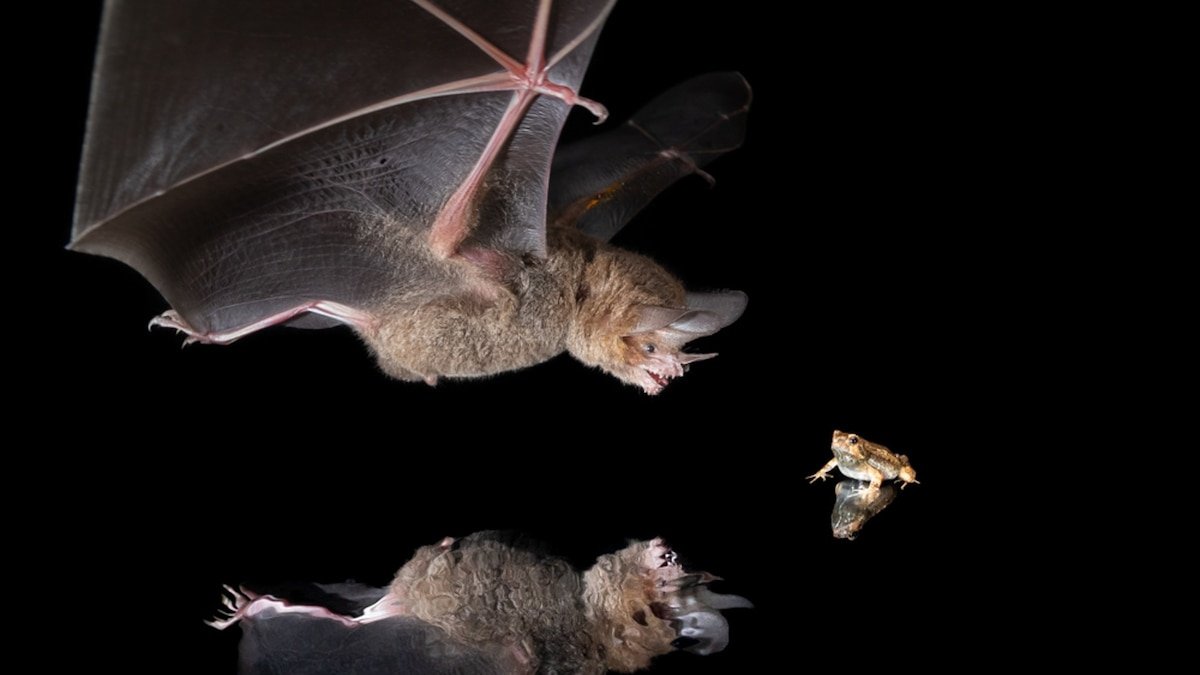During Panama’s wet season, forests boom with a chorus of túngara frog mating calls as males compete for females’ attention.But these calls put the frogs in a precarious position between sex and death. For a fringe-lipped bat, it’s as though its meal is ringing a dinner bell.
Bats navigate the world with echolocation, listening to the sound waves of their own calls bouncing off nearby objects. Their hearing is so precise they can even home in on prey using ripples that frog calls make on water.
But fringe-lipped bats have an additional auditory superpower. This woolly, wart-mouthed creature listens for frog and toad mating calls and can tell, just from the sound, which are tasty and which are toxic.
Now, scientists have found that adult bats are better at screening out “spam calls” than juveniles. The younger bats often wiggled their ears in response to the calls of poisonous toads, while adults ignored those calls, according to a new study in the Proceedings of the Royal Society B.
“That suggests to me that the juveniles have to learn, probably through experience, that those calls are not associated with a good meal,” said Logan James, lead author of the study and postdoctoral researcher at McGill University.
The study is “an excellent reminder that behavior is plastic and shaped by experience, by learning,” said Mirjam Knörnschild, professor of evolutionary ethology at the Humboldt University of Berlin, who was not involved in this study.


By analyzing video footage, scientists discerned that fringe-lipped bats learned over time which calls came from prey that was safe to eat. Juvenile bats may learn this through trial and error or from their mothers.
Photographs By Grant Maslowski
A nature vs. nurture story
Data for the new study originated nearly 17 years ago with Rachel Page, a staff scientist at the Smithsonian Tropical Research Institute in Panama and a senior author on the study. Native to southern Mexico and parts of Central and South America, this is the only bat species known hunt by listening to frog calls.
Page wanted to know if the bats were genetically hard-wired to identify frog calls, or if they learned these calls from experience.
When she was a graduate student, Page and her team collected the calls of 15 different species of frogs and toads—a combination of recordings they and colleagues had gathered at the Smithsonian Tropical Research Institute in Panama. They put wild juveniles and adult bats in a cage with a speaker covered with a screen and dead leaves and video recorded the bats’ responses to each call.
In the summer of 2023, some fifteen years after the video data was first collected, James began analyzing the data while serving as a visiting researcher at the Smithsonian’s Panama outpost. James and colleagues found that juveniles and adults, on average, both showed an interest in frogs of a size appropriate to eat.
But unlike adults, some juveniles showed little interest in the calls from frog species that this type of bat often eats, such as the túngara.
And some young bats reacted to poisonous toads by moving their ears, flexing their wings, or flying to the speaker broadcasting the call. One pup even attacked the speaker when it played the call of a poisonous species.
You May Also Like
“The fact that these juvenile bats respond so strongly to some of these toad calls really does tell us that they must be changing their strategy over time,” James said.
Learning to eavesdrop
The new study does not rule out the idea that the mothers of the young bats teach them about frog calls. And a 2022 study found that bats learn navigation from their mothers. There could be a combination of social learning and trial-and-error at play, Page said.
“The mom and pups do associate for long periods of time in the wild, even after weaning. So it seems like lots of opportunity for social learning to take place there,” Page said. “But we also see that they’re very, very quick through their own individual experience to acquire new prey quality associations.”
One piece of evidence in favor of the “learning from experience” hypothesis comes from a previous study from Page’s lab, which trained bats of the same species to fly toward certain ringtones but not others. Scientists showed bats maintained the association with the ringtones for up to four years.
Eavesdropping is an important skill for many animals, including humans. Studying these bats allows researchers to explore a cognitive ability they share with us to listen for cues in nature and make decisions based on what they hear.
Bats learning to pick out the call of a tasty frog from the cacophonous auditory background, and pounce on it, is akin to how we learn the sound of our own names, James said. We perk up when we hear our name mentioned even at a crowded party, and “these bats also learn to selectively attend to important sounds and ignore others,” he said.
To follow up on the new results, James, Page, and others are working on a study exploring how the bats respond to a mixture of calls from different frogs and toads. Page’s lab is additionally researching the bats’ hunting behavior by equipping bats with mini-backpacks carrying tiny microphones and sending them back into the wild.
Long-term, the two researchers plan to explore the extent to which bats may share some
of the fundamental building blocks of human communication, including speech and music.
While Page studies multiple bat species, the fringe-lipped type has fascinated her since her doctoral research on it about two decades ago. “You think, ‘Okay, I think I understand it now,’ and then a whole new suite of questions will unfold.”











